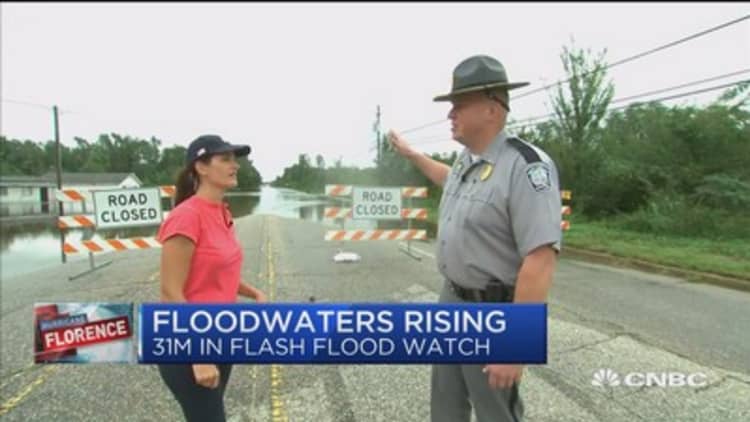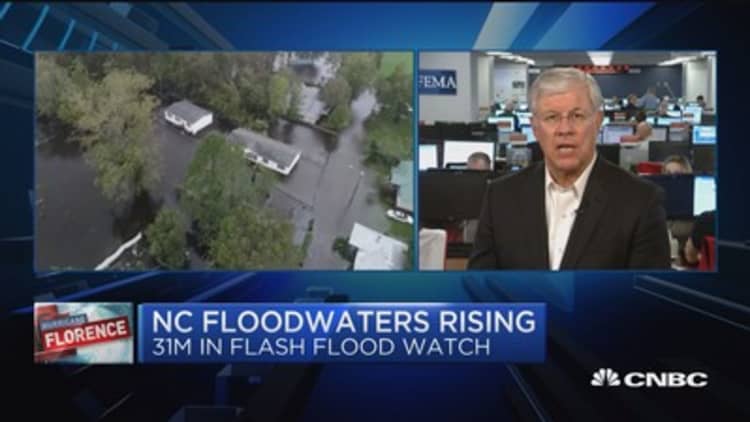Property damage and disruption from Hurricane Florence is expected to total at least $17 billion to $22 billion, but the estimate could end up being conservative, as the Carolinas continue to face historic rainfalls and flooding, according to Moody's Analytics.
"We were close to $10 [billion] to $15 billion on Friday. The flooding is more extensive than we had anticipated, and the storm was slow moving. It hung over the Carolinas a lot more than was expected," said Mark Zandi, chief economist at Moody's Analytics. He said the number could be adjusted based on further flooding, as some rivers are not expected to crest until later in the week.
Moody's said Florence is among the 10 costliest hurricanes.
Economists expect Florence, which came ashore Friday as a Category 1, to have a slight impact on the U.S. economy despite the severe devastation to homes, businesses and vehicles in its path. Florence was quickly downgraded to a tropical storm and is now a tropical depression, but its rainfall of 24 inches was a record for a hurricane, surpassing 1999's Hurricane Floyd.

"These estimates are based on the information available, and there is a high probability that Florence's costs will be revised significantly higher with added information or inland flooding," according to Moody's Analytics.
The anticipated loss to economic output is $1 billion to $2 billion, amounting to about a 0.2 percentage point hit to GDP, according to Zandi.
Costs of hurricanes vary based on the severity and region affected, and costs have been rising because of increased construction in coastal areas and with rising sea levels.
Zandi said the business damage would have been worse if the hurricane had moved closer to either the port of Charleston, South Carolina, or Norfolk, Virginia.
Zandi said the economy has several weeks to make up for the lost output this quarter. "It's a strong quarter. The growth rate is 3.5 to 4 percent. A tenth or two for an economy growing at 1 percent is a very different thing than for an economy growing at 3.5 to 4 percent," he said. There also was catastrophic damage on the West Coast from fires that detracted from second- and third-quarter growth.
The National Weather Service warned that flash floods, landslide warnings and "prolonged" and "significant" river flooding will continue for the next few days, the National Weather Service said. North Carolina has had 40 inches of rain since Thursday. The inland flooding could result in the National Flood Insurance Program taking a hit as opposed to private insurers.
"Based on our methodology, it's too early in the process to get a full read on [third-quarter growth]," said Macroeconomic Advisers economist Ben Herzon. He said he is awaiting updates from FEMA, which describes areas of the Carolinas as under emergency but has not yet reported them as actual disasters.

Herzon said the share of GDP in the Florence-affected areas is about half that of Harvey and one-sixth that of Irma. Harvey came ashore in Texas last August, causing devastating flooding in Houston, and Irma made landfall in the Florida Keys before traveling up the west coast of Florida last September.
Herzon also said he expects little to no impact on September payrolls but that average hourly wages, which rose near 3 percent on an annual basis last month, could get a temporary lift from the storm.
While wages for salaried workers would likely remain the same, the hours worked in the hurricane region fell as employees were unable to get to work or evacuated. That should result in an increase in average hourly wages for September.
But there should not be much impact on the number of jobs, because of the timing of the hurricane. Employees are counted as working if they worked any time in the pay period that included the 12th of the month, which was last Wednesday.
"I do not believe there will be a payroll employment impact. It's because the BLS [Bureau of Labor Statistics] defines someone as employed if they were at work or received pay for any portion of the pay period. It's the week that includes the 12th. That's about 20 percent of all pay periods. If they're on a standard Sunday through Saturday, and they were at work on Monday and evacuated Tuesday, they would be counted," he said. About 20 percent of workers are on a weekly pay period, and many others are biweekly or even monthly.
WATCH: Too early to assess flood damage, says NFIP exec.



